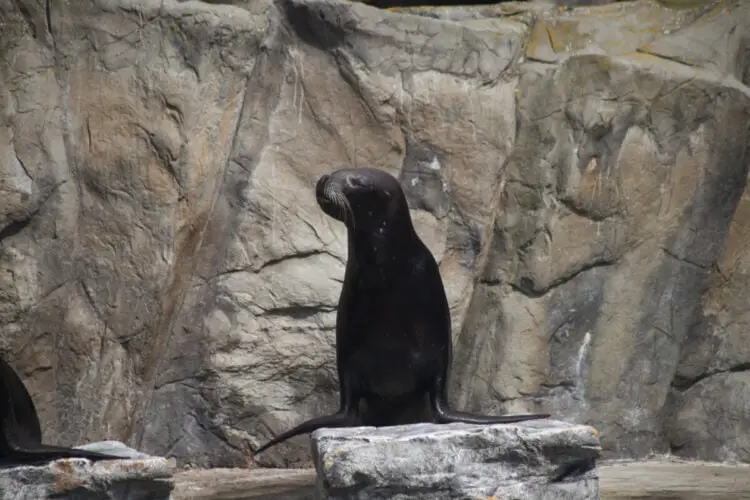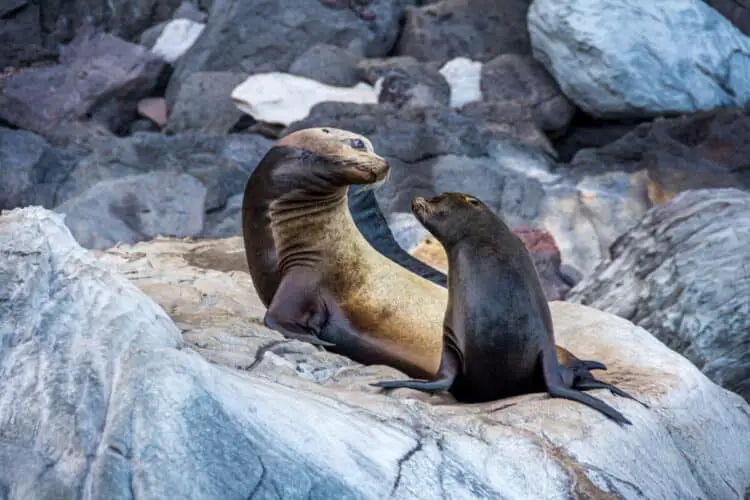The Guadalupe fur seal, scientifically known as Arctocephalus townsendi, is a marine mammal that inhabits the waters of the eastern Pacific Ocean. This species primarily resides on the rocky shores and islands of Guadalupe Island in Mexico.
The physical characteristics of the Guadalupe fur seal include a streamlined body, thick fur, and long flippers that aid in swimming and hunting prey. These seals exhibit a variety of behaviors, such as diving for extended periods to search for food and engaging in territorial disputes with other individuals. They also exhibit a hierarchical social structure within their colonies.
Feeding habits are an essential aspect of this species’ survival, with the Guadalupe fur seal mainly consuming fish and squid found within its habitat. Despite being classified as endangered by international conservation organizations, this species faces numerous threats including entanglement in fishing gear and illegal hunting.
Conservation efforts have been implemented to protect these seals through regulations on fishing practices and the establishment of marine protected areas.
Given their ecological importance as top predators in marine ecosystems, safeguarding the Guadalupe fur seal is crucial for maintaining overall ecosystem balance and biodiversity. Understanding their habitat requirements, behavior patterns, feeding habits, threats they face, and ongoing conservation efforts will contribute to effective management strategies aimed at ensuring their long-term survival.

Habitat and Distribution
The habitat and distribution of the Guadalupe Fur Seal is crucial for its survival. It relies on specific environmental conditions in order to thrive and maintain a healthy population. This species is endemic to the islands off the coast of Baja California, Mexico. Guadalupe Island is their primary breeding ground. These seals prefer rocky coastal areas and sea caves as their habitats due to their nesting and rookery needs.
Conservation efforts have focused on protecting these critical habitats. The goal is to prevent human disturbance, pollution, and overfishing. The Guadalupe Fur Seal faces various threats. These include entanglement in fishing gear, predation by sharks, disease outbreaks, and climate change impacts. Therefore, the importance of protection cannot be understated. It is necessary to ensure the long-term survival of this unique species.
Physical Characteristics
Characterized by a sleek and streamlined body, the Guadalupe fur seal possesses a distinctive external appearance. This species is the second smallest of all fur seals, with adult males measuring around 1.8 meters in length and weighing up to 150 kilograms.
The coat of the Guadalupe fur seal is thick and dense, composed of two types of hair: long guard hairs and short underfur. The coloration varies between individuals, ranging from dark brown to grayish-black on the upper body and lighter on the underside. These physical characteristics are the result of an evolutionary history that has allowed them to adapt to their marine environment.
The reproductive cycle of Guadalupe fur seals is highly synchronized and regulated by hormonal changes. Breeding occurs annually during summer months when males establish territories on rocky shores for mating purposes. After a gestation period of about 11 months, females give birth to single pups in late spring or early summer.
The mother provides care and nourishment for her pup through lactation for approximately four months before weaning occurs. This reproductive pattern ensures the survival and continuation of this unique species in its habitat off the coast of Baja California.
Behavior and Social Structure
With a highly synchronized reproductive cycle, the Guadalupe fur seal demonstrates a complex social structure and behavioral patterns.
Social interactions play a crucial role in their daily lives, as they form large colonies during the breeding season. These colonies are composed of territories that are defended by dominant males.
The males engage in aggressive displays to establish their dominance and attract females for mating. This includes vocalizations, posturing, and physical confrontations with rival males.
Females, on the other hand, exhibit an interesting behavior known as delayed implantation, where fertilized eggs do not immediately implant into the uterus but remain dormant for several months before development begins.
This adaptive strategy ensures that pups are born during optimal conditions for survival.
Overall, understanding the behavior and social structure of Guadalupe fur seals is essential for effective conservation measures aimed at protecting this endangered species.
Feeding Habits and Diet
The feeding habits and diet of the Guadalupe fur seal are influenced by their ecological niche and available food resources. These seals are known for their efficient foraging behavior, as they search for prey both nearshore and offshore.
They primarily feed on fish species such as anchovies, sardines, rockfish, and hake. However, prey preferences can vary depending on the location and time of year. Studies have shown that Guadalupe fur seals adapt their feeding strategies based on the abundance and availability of prey species in their environment.
This flexibility allows them to optimize their energy intake while maintaining a balanced diet. Understanding the feeding habits of these seals is crucial for conservation efforts, as changes in prey availability due to overfishing or climate change can significantly impact their survival and reproductive success.
Conservation measures should be implemented to protect the marine ecosystems that support the dietary needs of this vulnerable species.

Threats and Conservation Efforts
Threats to the Guadalupe fur seal population and ongoing conservation efforts are of critical importance in ensuring the long-term survival and recovery of this species.
One of the main conservation challenges is the historical population decline of the Guadalupe fur seal, primarily caused by overhunting during the 18th and 19th centuries. This led to a significant reduction in their numbers, with only a few hundred individuals remaining by the early 20th century.
Although hunting has been banned since 1928, other threats continue to impact the species’ recovery. These include entanglement in fishing gear, habitat degradation due to pollution and climate change, as well as competition for food resources with other marine mammals.
To address these challenges, various conservation efforts have been implemented. These include monitoring population trends, protecting important breeding habitats, promoting sustainable fisheries practices, and raising public awareness about the need for Guadalupe fur seal conservation.
Importance of Protecting the Guadalupe Fur Seal
The Guadalupe fur seal faces numerous threats to its survival, including climate change, habitat degradation, and entanglement in fishing gear. To combat these challenges, conservation efforts have been implemented to protect and restore the population of this species.
However, it is important to understand the significance of protecting the Guadalupe fur seal beyond its intrinsic value as a unique marine mammal. This species plays a crucial role in maintaining ecosystem balance and provides important economic benefits.
The presence of these seals attracts tourists who contribute to local economies through ecotourism activities. Additionally, their diet primarily consists of fish and squid which helps regulate prey populations and maintain the overall health of marine ecosystems.
Protecting the Guadalupe fur seal ensures not only its persistence but also supports healthy ecosystems and sustainable economic growth.
